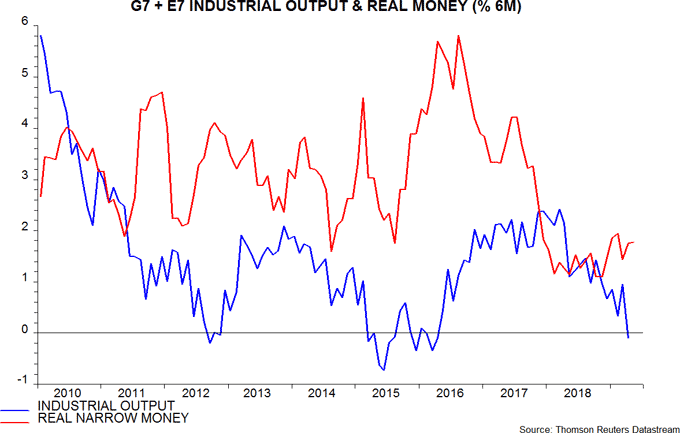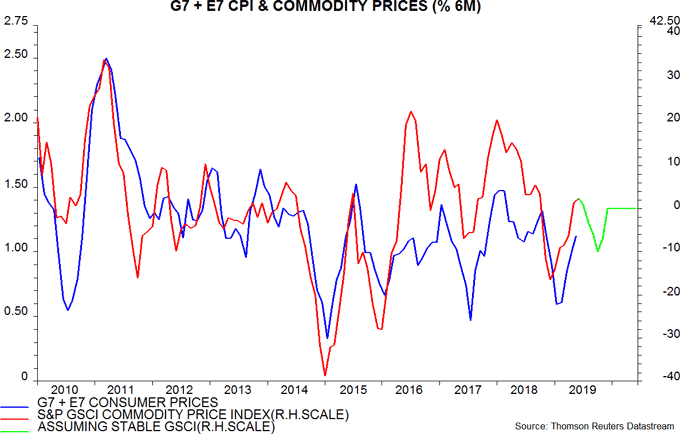Entries from June 9, 2019 - June 15, 2019
Global money update: no recovery signal yet
Six-month growth of global nominal narrow money appears to have risen to a 16-month high in May but an increase in inflation resulted in little change in real money expansion, which continues to languish at a low level by post-GFC standards. Global economic momentum is expected to reach a trough in the third quarter and remain weak into early 2020.
The US, Japan, China, Brazil and India have released May monetary data, together accounting for two-thirds of the G7 plus E7 aggregate tracked here. Assuming unchanged growth in other countries, six-month nominal narrow money expansion is estimated to have reached its highest level since January 2018 – see first chart. The May rise was due to firmer growth in the US, Japan and China, which offset slowdowns in Brazil and India.

As expected, however, six-month consumer price inflation also increased further in May, reflecting a recovery in energy and other commodity prices in early 2019. Six-month real money expansion, therefore, is estimated to have been unchanged at 1.8% in May, below a recent high of 1.9% in March, though up from a low of 1.1% in October / November 2018.
Full April data confirm that the six-month change in G7 plus E7 industrial output turned negative – second chart. Based on the October / November low in real money growth, output momentum is expected to weaken further to a low around September, with limited revival into early 2020.

The judgement here remains that a rise in six-month real narrow money growth to 3% is needed to signal an economic recovery – a move through 3% occurred before all seven previous rebounds in global economic momentum since the 2008-09 recession.
An increase, on balance, appears likely. The recovery in nominal narrow money growth is hopeful and may extend in response to government bond yield declines and policy easing. Recent commodity price developments, meanwhile, suggest that inflation trends will shift from being a headwind to real money growth to a modest tailwind – third chart.

China May money / credit data: insufficient improvement
Six-month growth rates of narrow money (true M1) and broad credit (total social financing) rose in May but remain weak by historical standards – a further pick-up is needed to warrant shifting to a more optimistic view of economic prospects.

The rise in nominal money / credit growth in May was offset by an increase in six-month CPI inflation, due to surging food prices – real rates of expansion were little changed.

Suggested implications:
1. Economic data will remain weak through Q3 and, probably, Q4.
2. Further policy easing is required and likely.
3. Prospects for early 2020 are improving.
Labour market watch: US / UK weakness
Incoming news remains mostly supportive of the view here that economic weakness is spreading to labour markets.
US non-farm payrolls undershot expectations in May but the series is volatile, arguing for smoothing data over several months. Three-month growth of a three-month moving average of private payrolls fell further to the bottom of the range of recent years, with weakness confirmed by aggregate hours worked – see first chart.

Today’s UK labour market report reported a fourth successive monthly decline in May in the stock of vacancies, which leads employees in employment. The employees series recovered in April but remained below a February peak – second chart*.

A rebound in annual growth of private sector regular pay to 3.8% in April partly reflected a base effect, with three-month growth of a three-month moving average subsiding further – third chart.

Last week’s news of a further fall in the Euroland unemployment rate from 7.7% to 7.6% in April was against the global trend of softer data. The decline was driven by a drop from 14.0% to 13.8% in Spain, while rates in Germany, France and Italy were unchanged – fourth chart. As previously noted, German registered unemployment rose in May, even after adjusting for a reporting change distortion, while vacancies fell for a second month.

*Both series are reported as three-month moving averages.

